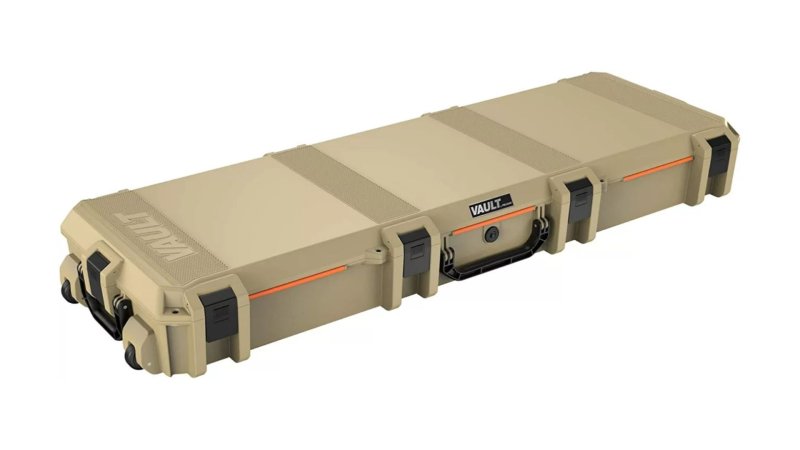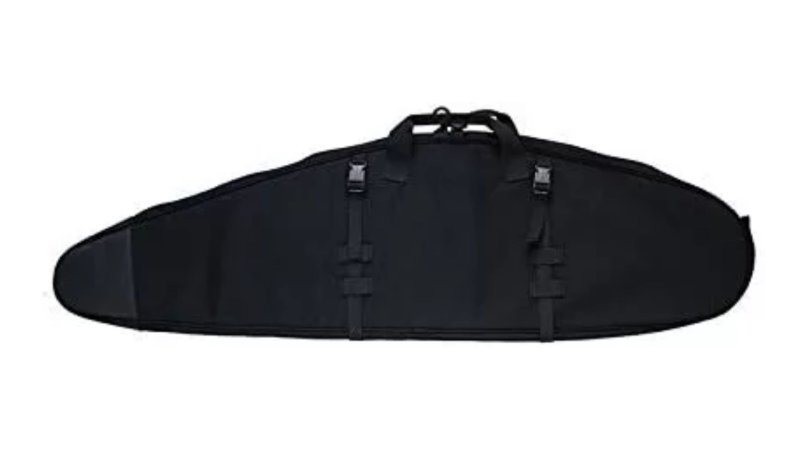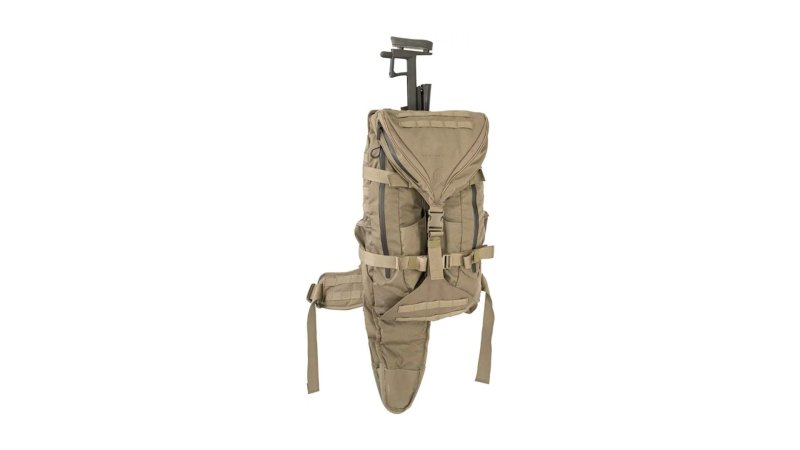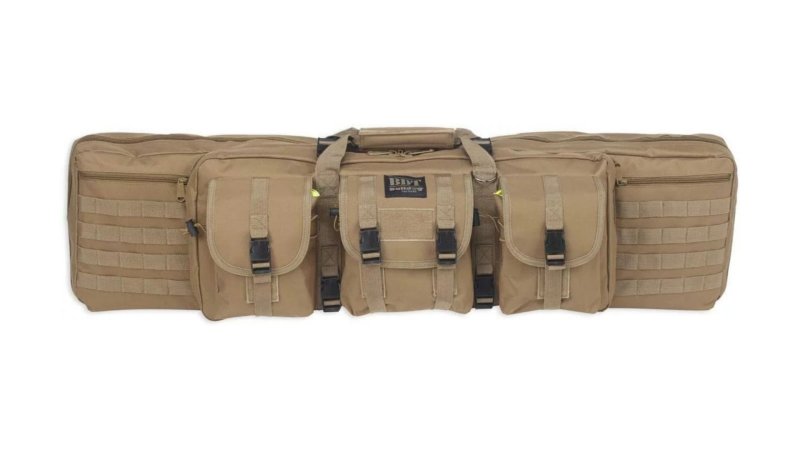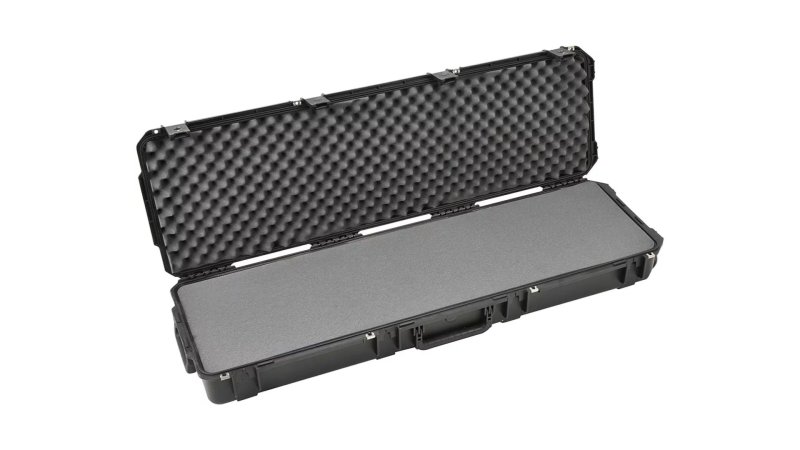

We may earn revenue from the products available on this page and participate in affiliate programs.
There are plenty of options for rifle cases in the world. Sure, you can throw your rifle in a shopping bag or a tennis racket case, like some people. And as cool as that looks in that one low-budget John Wick knockoff you saw that one time, it doesn’t do much to protect your rifle in transit. That’s why I took the time out of my day to sit down with the cases I own and what the market offers to narrow down the best options for you and what you need.
We’ve lined up some of the best rifle cases on the market today to help you sort through the nonsense and make the right purchase. A good gun case isn’t just going to be a bag to stuff your rifle into, it will protect it in transit, support accessories, and carry your mags — and more — without breaking the bank.
Methodology
When selecting a rifle case, it’s important to keep in mind the purpose of the case. Whether it’s just a day trip to the range or a three-day hike into the woods for that perfect hunting spot, you need a case that’s going to suit the job. So, I tried to approach this exercise from a position of meeting the needs of the mission rather than just the weapon.
To select rifle cases for this guide, I started out by searching Google Shopping and Amazon to find the most common results. Next, I narrowed my search to items I either own or have handled, and I also included items from reputable companies I have worked with before. I read through customer reviews as well, looking for basic issues and ideas I’ve encountered on my own.
At this point, I reviewed the features and functionality available to the individual options. I considered things like materials, design principles, and ease of use. I compared items I already own or am familiar with, or, in the cases of items I own, handled personally. I tried to think through how cases would handle in the real world, flaws I’ve encountered myself, and features I know make a product better.
When possible, I reached out to manufacturers directly, raising any questions or concerns I had developed through my research process, trying to resolve those concerns. I spoke to fellow gun owners and enthusiasts as well, trying to get outside input on features and issues I’d encountered. Insofar as the items I had access to myself, I put them to the test, carrying them to the range, through the woods, and putting them through the ringer as much as possible before developing an opinion. I did everything possible to explore the quality and means of the products as much as possible, through whatever avenues available.
Furthermore, it’s of the utmost importance to the Task & Purpose team that our readers know our commitment to open, fair product recommendations and reviews, and that you can trust us to provide you with unbiased, balanced information.
Best Overall
Pelican Vault Series
Pros
- Extremely rugged construction
- Comes in a variety of styles (2-gun, 1-gun, etc)
- Superb, lockable latches
- High-quality internal foam protection
Cons
- Doesn’t come standard with cutout foam
- Limited color options
Product Specs
- Case type: Hard case
- Material: Polyethylene
- Locking: Yes
- Purge valve: Yes
Best Value
Eberlestock Sidewinder-AR
Pros
- High-quality construction
- Simple, straightforward design
- Cleaning rod pocket is a unique feature
- Mountable to other bags
Cons
- Limited storage
- Lacks features of other products
Product Specs
- Case type: Soft case
- Extra pockets: One
- MOLLE webbing: Limited
Editor's Choice
Grey Ghost Tactical Rifle Case
Pros
- Internal hook-and-loop means custom configurability
- Detachable shoulder strap for easier carrying
- Quality padding for excellent protection
Cons
- Few extra pockets limits storage ability
Product Specs
- Case type: Soft case
- Extra pockets: Two, internal mesh
- MOLLE webbing: None, internal hook-and-loop
Best for Hunting
Eberlestock J34 Just One Bag
Pros
- Modular, adjustable design
- Large carrying capacity
- Classic Eberlestock quality
Cons
- More of a backpack than a typical rifle case
- Modularity requires buying additional products
Product Specs
- Case type: Hunting pack
- Internal volume: Up to 4,200 cubic inches
- Scabbard length: 34 inches
Best for Range Day
Bulldog Tactical Single Rifle Case
Pros
- Immense storage space
- Interior, bungeed magazine pouches for retention
- Spacious interior fits most firearms
Cons
- Less protection than some other options
Product Specs
- Case type: Drag bag
- Extra storage: Numerous, large exterior pockets, interior mag pouches
- Length: 43 inches
Best Competition
SKB iSeries 5014-6 3 Gun Competition Case
Pros
- Designed with 3-gun comp in mind
- Meets MIL-STD 810G
- Stackable interior fits everything needed for a competition
Cons
- Price
- TSA locking latches aren’t standard (but accepts padlocks)
Product Specs
- Case type: Hard case
- Material: Polypropylene
- Locking: Yes
- Purge valve: Yes
Our verdict on rifle cases
All in all, it’s hard to beat Pelican at the game it practically invented. The Vault Series is built by masters at the trade, purpose-built to satisfy all your needs as someone carrying a rifle. And, when you don’t want to spend $100 or more, Eberlestock has the reputation to back such a great value. You can’t go wrong with these two options. If there’s anything we missed, please, throw it down in the comments, because every new gun case is an excuse to buy a new gun
What to consider when buying a rifle case
When buying a rifle case, it’s important to remember the key features and what you need the case to do. Shoulder straps, hard or soft, long-term storage, TSA compatibility, and extra storage space are all important features to keep in mind.
Types of rifle cases
Hard case
These are your classic tough, box-style, hard-sided cases. Usually made from injected-molded plastics and clip shut, they can run the widest range in quality. Many rifles will come in their own cheaply manufactured hard cases, with flimsy clips that barely latch and hinges that are prone to break, but on the other end of the spectrum, you see enormously well-constructed bunkers with pressure relief valves, dual wall construction, and laser-cut foam cutouts on the inside. Pelican famously used to drop its rifle cases out of a helicopter to demonstrate the ruggedness of construction, and there are now several competitors in that range of high-quality construction.
Soft case
Soft rifle cases are your classic soft, handbag-style carry cases, usually complete with padded interiors to protect the rifle from impact. They’re lighter, easier to carry around, pack in a trunk and work with in general, at the cost of less protection. These can often overlap with drag bags, especially when enough extra storage pouches are slapped on. You’ll also see backpack-style soft cases, usually for hunters who need to travel long distances into the woods with all their gear, in addition to a scoped rifle they want to protect from the elements.
Drag bag
Drag bags started off as a military rifle carry option where it was necessary to have a durable soft case bag that carried all the assorted accouterment associated with the weapon stored inside. Called so because of their ability to literally be dragged behind a crawling sniper in the field, they have evolved into a reliable rifle case option in their own right. The hallmarks of a drag bag are extensive storage and high-quality protective construction. Think of it as a go-bag for the gun inside, bearing all the magazines, accessories, and maintenance gear the weapon needs to function in the field, and you’ve got the right idea. Many drag bags even still bear a loop at the top, used for the dragging that gave this class its name.
Key features of rifle cases
Protection
The most important feature of a rifle case is the ability to protect what’s inside. Otherwise, you may as well be carrying the rifle without a case at all. Quality soft cases use thick padding to protect the rifle from external impacts, but also often have internal padding to protect rifles from each other (in the case of multi-gun cases). Hard cases will have hard, molded exteriors, foam interiors, and even be constructed to keep dust, moisture, and other elemental features from reaching the guns inside.
Storage space
Having the ability to carry everything you need is also key when it comes to selecting the right rifle case for you. Sometimes, you just need something that’s going to hold the rifle itself, and that’s good enough. But there are times when you want to be able to carry more; magazines, hearing protection, maintenance and cleaning tools, and more. Some hunting cases even have the ability to carry game after a successful trip. Make sure you know what you’re going to need from the gun case, and bear that in mind when choosing which case is right for the job at hand.
Transportability
Last, but still very important, is transportability. Handles, shoulder straps, wheels on a hard case, all of these are great features to consider when choosing between similar cases. No matter how great a case might be, it’s not that great if it’s a hassle to haul from your car to the shooting stand, or wherever else you might be taking it.
Rifle case pricing considerations
Rifle cases can run a huge range of prices, from several hundred dollar items priced for government sales, to the cheapest of dollar store quality products. It’s important to understand what you’re getting for your money in order to avoid overpaying, or worse, buying something that won’t do the job.
Budget
The typical cut-off for a reasonably priced budget bag is around $100. Items less than $50 to $60 are likely to be of extremely poor quality, so you want to fork out a little extra to make sure it’s a good product, but you don’t have to break the bank to do so.
Mid-range
Around $100 to $250, and you’re seeing the bulk of decent rifle cases, be they hard or soft cases. On the lower end, you’ll typically see decent soft side cases that will hold up to abuse, while at the upper end, you’re getting quality hard side cases with some good features.
Premium
Over $250, and you get the top-of-the-line gear, the cases that can hold up to tremendous abuse, or have such a glut of features as to be useful for almost any activity. This is also where you’ll see extremely specialized cases from reputable, specialized manufacturers.
Tips and tricks
As mentioned above, the most important thing to consider when choosing a rifle case is what you’ll use it for. The case you would use to transport your rifle across the country in your trunk is probably not the same one you’d want to use for a hike out to your favorite hunting spot. Think about the things you’ll need the case to do, and go from there. Some key features to remember:
- Purge vents for atmospheric changes and releasing moisture can be important for longer trips, airline travel, and long-distance storage, and are common on higher-end hard cases.
- If you plan to fly with your rifle, TSA requires that you use a hard case that locks with a padlock. For more TSA rules regarding travel with firearms and ammo, click here.
- External storage pockets and internal storage spaces can allow for much greater flexibility in what items come along with the rifle, meaning fewer bags to carry on a range day or other similar trips.
FAQs about rifle cases
You’ve got questions. Task & Purpose has answers!
Q: What type of gun cases are TSA-approved?
A: TSA requirements for a gun case are that it be hard-shelled, locked, and the firearm must be unloaded. The firearm must also be declared at check-in, and cannot be in carry-on luggage — checked baggage only. Note that ammunition must not be accessible, meaning you cannot store the ammunition in the same case as the firearm.
Q: Is a hard rifle case better than a soft rifle case?
A: This depends entirely on your needs. For TSA purposes, a hard rifle case is mandatory, but for other day-to-day uses, a soft case might better serve your needs. For scoped rifles, a hard case is usually preferable, as it better protects the optics from being rattled out of zero.
Q: Do rifle cases lock?
A: Not all rifle cases are lockable. If you’re going to purchase a case for flying, make sure you check this first. Most manufacturers offer lockable TSA-compliant firearms cases.
Q: Can I fly with two guns in a case?
A: There are no rules against multiple firearms in a single case. As long as the case is locked, and no ammunition is present in the case, you’re clear to fly.
